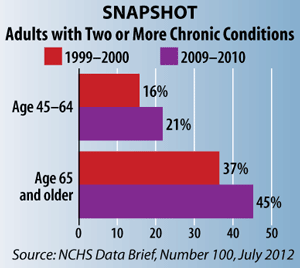Growing Number of Adults Have Multiple Chronic Conditions
The prevalence of adults with two or more chronic conditions continues to rise significantly in the U.S., driven primarily by increases in hypertension, diabetes, and cancer, according to a data brief from the National Center for Health Statistics (NCHS). In 2009–2010, 21% of adults age 45–64 and 45% of adults age 65 or older had been diagnosed with two or more chronic conditions. In addition, increasing numbers of those with multiple chronic conditions either do not receive or delay care due to cost.
NCHS researchers compared two data sets from the National Health Interview Survey, 1999–2000 and 2009–2010. During that 10-year period, the percentage of adults age 65 or older with both hypertension and diabetes increased from 9% to 15%, with hypertension and heart disease 18% to 21%, and with hypertension and cancer 8% to 11%.

The increase in multiple chronic conditions was evident in all racial and ethnic groups studied. Between 1999–2000 and 2009–2010, the percentage of adults age 45–64 with two or more chronic conditions increased 20% for non-Hispanic blacks, 35% for non-Hispanic whites, and 31% for Hispanics. The prevalence was highest among non-Hispanic blacks, growing from 44% in 1999–2000 to 52% in 2009–2010.
Income level also showed a significant effect on the prevalence of multiple chronic conditions. In both time periods, the prevalence of two or more chronic conditions for adults age 45–64 decreased with rising family income, and it was more than twice as high for those living in poverty compared to those at 400% or more of the poverty level.
The study also found that those with multiple chronic conditions increasingly skip necessary care and medications, especially those in the 45–64 age group. Over the 10-year time period of the study, the number of these adults who did not get care or delayed care increased from 17% to 23%, and for those who did not fill prescriptions, 14% to 22%. For those age 65 or older, the numbers remained about the same across the board in these categories, about 7%.